ZAN DAR TAWRĀT WA QURĀN: TA’AMMULĀTĪ DAR BĀB JĀYGĀH ZAN [ WOMAN IN THE TORAH AND THE QURAN: REFLECTIONS ON THE STATUS OF WOMAN]. By Mohammad Hossein Moezi. Qom, Iran: Zohal, 2022. Pp. 156. Paper. 1,500,000 IRR.
More comprehensive works, opinions, and reviews exist in the academic and interfaith research community. However, the main feature of this study is its approach and the formulation of questions based on authentic principles. The focus of this writing is not to judge or compare the perspectives of Islam and Judaism regarding the status of women, but rather to provide a report on the teachings and rulings of these two religions.

This work consists of five chapters. The first chapter provides a comprehensive overview of women through the lenses of Islam and Judaism, critically engaging with their respective sacred texts and interpretations. It examines the status, position, and rights of women in Judaism while referencing historical contexts and Jewish rulings. The author highlights the significance of women in Judaism by invoking the proverb from Proverbs 18:22: “A man who finds a wife finds a good thing and receives favor from the Lord.” This statement serves to underscore the positive perception of women as integral to both family and community life. However, the author also reflects on the complexities of women’s roles, illustrating how certain interpretations of the Torah and Talmud elucidate a nuanced hierarchy that can lead to varied social standing for women. In contrast, the examination of women’s position in Islam illustrates how Quranic verses position women as equal to men in terms of their humanity and spiritual capabilities, and yet clearly delineates differing rights that are attributed to innate physical and sexual differences. The author recognizes the tension between these notions of equality and distinct roles, prompting a discussion on how these varying rights impact the social fabric of both religions.
The second chapter provides a succinct introduction to the Torah and the Quran. It begins with the historical background that situates the Torah as a foundational text written in Hebrew approximately a millennium before Christ, considered sacred by both Jews and Christians. The chapter’s exploration of the Septuagint, the Greek translation of the Old Testament, is particularly insightful, presenting it as a pivotal moment that allowed Jewish texts to reach a broader audience in the Eastern Mediterranean. This accessibility highlights an early instance of cross-cultural engagement with sacred texts. In describing the Old Testament’s division into Torah, Nevi’im (Prophets), and Ketuvim (Writings), the author emphasizes how these sections frame the Jewish understanding of divine revelation. This contrasts with the introduction to the Quran, which the author claims was revealed comprehensively to Muhammad in the 7th century CE. The Quran’s encapsulation of diverse themes—beliefs, social rules, and moral exhortations—forms a bridge to understanding how Islamic doctrine encompasses a wide array of societal norms and ethical teachings.

The third chapter delves into the specific status of women as portrayed within the worldviews of Islam and Judaism. The author begins with the creation narrative, contrasting the accounts in the Torah and the Quran: while the Torah depicts Eve as being created from Adam’s rib, thereby influencing interpretations of women’s subordination, the Quran asserts that both Adam and Eve were created from clay, promoting a view of shared dignity and accountability in humanity’s fall from grace. The discussion of the Ten Commandments, particularly the commandment to honor one’s parents, serves to highlight the importance of familial structures that include both mothers and fathers. Here, the author critically engages with feminist interpretations of these texts, suggesting that although the Torah places a significant value on women’s roles within the family, historical and textual interpretations have often led to their marginalization. The Quran’s portrayal of women as equal heirs to spiritual rewards and the emphasis on their roles as peace-bringers and blessings within families underscores a more egalitarian tone—though the author acknowledges that interpretations of modesty and chastity emerge as both empowering and constraining for women in practice.
The fourth chapter addresses behavioral topics concerning women as outlined in the Torah and the Quran. The author begins with an exploration of women’s rights, noting the complexities of inheritance and divorce laws that exist within both faiths. The Torah grants inheritance rights to women, conditional upon familial structures, while the Quran delineates inheritance shares that can be seen as unequal yet are justified through social frameworks. The author challenges readers to consider the implications of these rulings in the context of societal value versus divine mandate. The discussion around divorce highlights a shared reluctance in both religions toward this practice, yet it points out how interpretations by scholars serve to protect women from potential injustice. By examining specific rulings on marriage, purity, and modesty, the author articulates a multifaceted conclusion to the question of whether women’s roles in these sacred texts signify a secondary status. The author emphasizes that perspectives within both Islam and Judaism, when explored deeply, reveal a rich tapestry of understanding that resists simplistic readings of gender hierarchy, instead reflecting a complex interplay of rights, responsibilities, and social standings that continue to evolve.
Hossein Baqeri
Tolou International Institute
